SAP数据导入方案
sap数据批量导入教程、BDC实例详细讲解步骤
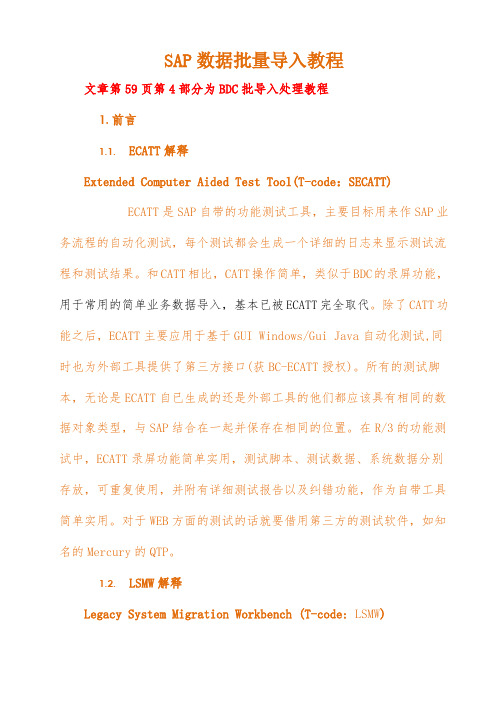
SAP数据批量导入教程文章第59页第4部分为BDC批导入处理教程1.前言1.1.ECATT解释Extended Computer Aided Test Tool(T-code:SECATT)ECATT是SAP自带的功能测试工具,主要目标用来作SAP业务流程的自动化测试,每个测试都会生成一个详细的日志来显示测试流程和测试结果。
和CATT相比,CATT操作简单,类似于BDC的录屏功能,用于常用的简单业务数据导入,基本已被ECATT完全取代。
除了CATT功能之后,ECATT主要应用于基于GUI Windows/Gui Java自动化测试,同时也为外部工具提供了第三方接口(获BC-ECATT授权)。
所有的测试脚本,无论是ECATT自已生成的还是外部工具的他们都应该具有相同的数据对象类型,与SAP结合在一起并保存在相同的位置。
在R/3的功能测试中,ECATT录屏功能简单实用,测试脚本、测试数据、系统数据分别存放,可重复使用,并附有详细测试报告以及纠错功能,作为自带工具简单实用。
对于WEB方面的测试的话就要借用第三方的测试软件,如知名的Mercury的QTP。
1.2.LSMW解释Legacy System Migration Workbench (T-code: LSMW)LSMW, 是SAP推荐用来从旧的系统或非SAP系统把大批量或周期性的数据迁移到SAP的主力工具,类似于ECATT/SCATT,其优点可以在一个Session中处理大批量数据,并灵活易学易用。
如果用BDC 和ECATT只能根据定制好的画面输入参数。
一旦没有这个值系统就会报错。
比喻我们根据业务对FI Account Document或者主数据一些参数作了扩展,一旦参数缺失或者不匹配,不得不终止Session,通过SM35手动去更正或者重新录屏。
LSMW具有一般的通用性,他导入模板的设计过程包括15个步骤,每个都是独立的单元并可进行单独的更新和修改,而不影响其它的模块只需作一些调整做出相应mapping,将必要的数据指定对应的字段就可行了,无需额外的编码。
SAP数据收集整理及导入策略

备注
FI 客户特殊总帐明细 FI 供应商应付明细 FI 供应商特殊总帐明细 FI 收入科目余额 FI 销售成本科目余额 FI 营业费用科目的余额 FI 管理费用科目的余额 FI 固定资产明细导入 需补数据 SD 销售订单 SD 交货单(未移库) SD 交货单(已移库) SD 发货及发票 PP 生产订单 PP 生产订单的订单BOM PP 完工确认数据 MM 物料移动凭证
CO 物料单价(生产性材料)
FI 一般未清项科目余额
FI GR/IR科目明细
FI 一般总帐科目的余额
FI 格(NP系统) 电子表格(NP系统) 电子表格(NP系统) 电子表格(NP加手工) 电子表格(NP加手工) 电子表格(NP加手工) 电子表格(手工) 电子表格(NP加手工) 电子表格(NP加手工) 电子表格(NP加手工) 电子表格(手工) 电子表格(NP系统) 电子表格(金蝶+手工) 电子表格(手工) 电子表格(手工) 电子表格(手工) 电子表格(手工)
针对销售订单无相关配 置信息的业务
CATT
手工输入
手工输入
MM 采购报价
MM 采购订单 FI 上线后的FI手工凭证 CO 在建工程的内部订单
原始单据
原始单据 原始单据 电子表格(手工)
手工
手工 手工 手工
手工输入
手工输入 手工输入 手工输入
MM 采购申请
MM 采购询价
电子表格(手工) 电子表格(手工) 电子表格(手工) 电子表格(手工) 电子表格(手工) 电子表格(手工) 电子表格(手工) 电子表格(手工)
电子表格(NP系统) 电子表格(NP系统) 电子表格(NP系统) 电子表格(手工) 电子表格(NP系统) 电子表格(NP系统) 电子表格(NP系统) 电子表格(手工) 原始单据
sap三种批量导入方法
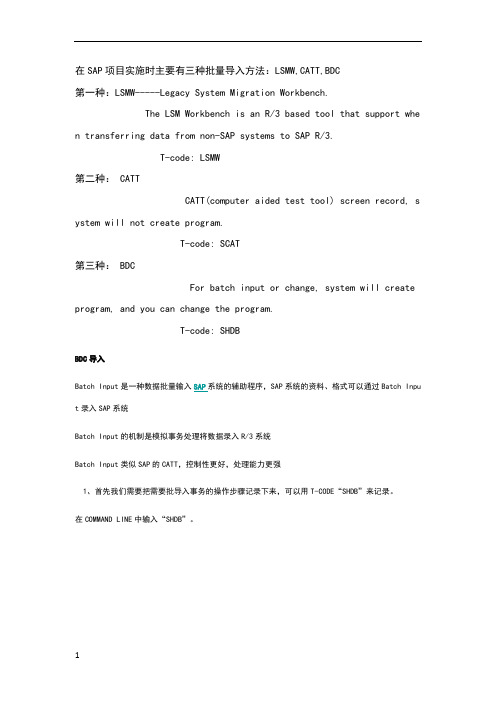
在SAP项目实施时主要有三种批量导入方法:LSMW,CATT,BDC第一种:LSMW-----Legacy System Migration Workbench.The LSM Workbench is an R/3 based tool that support whe n transferring data from non-SAP systems to SAP R/3.T-code: LSMW第二种: CATTCATT(computer aided test tool) screen record, s ystem will not create program.T-code: SCAT第三种: BDCFor batch input or change, system will create program, and you can change the program.T-code: SHDBBDC导入Batch Input是一种数据批量输入SAP系统的辅助程序,SAP系统的资料、格式可以通过Batch Inpu t录入SAP系统Batch Input的机制是模拟事务处理将数据录入R/3系统Batch Input类似SAP的CATT,控制性更好,处理能力更强1、首先我们需要把需要批导入事务的操作步骤记录下来,可以用T-CODE“SHDB”来记录。
在COMMAND LINE中输入“SHDB”。
2、进入TRANSACTION RECORDER界面3、点“NEW RECORDER”创建一个记录,现在以修改订单为例,键入记录名“ZAMAO”,输入事务代码“VA02”,然后“START RECORDING”。
4、下面的任务就是记录下修改订单的操作步骤。
5、填入订单号码,按确定6、现在来增加一下订单的PO DATE。
7、填入“,点“保存”。
8、这样就完成了一个最最简单的BDC录取工作,录完之后会出现系统运行的操作的跟踪,包括程序号,屏幕号,字段名,值等等,下面的任务是根据这些写到程序里面以完成SAP自动跑订单修改的这一动作。
SAP期初上线导入步骤
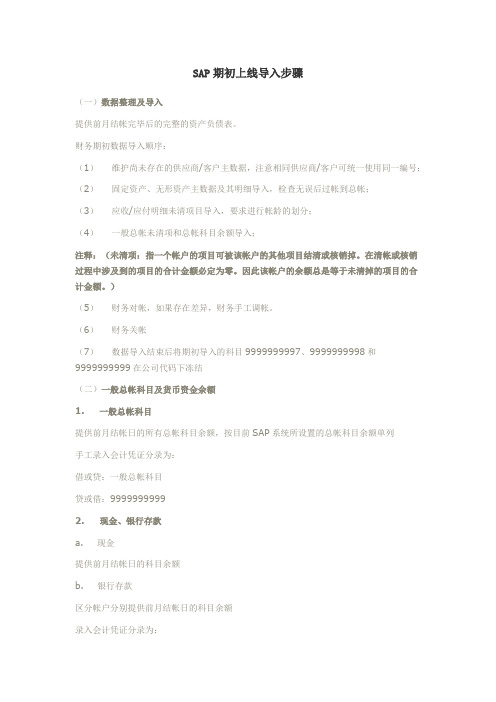
SAP期初上线导入步骤(一)数据整理及导入提供前月结帐完毕后的完整的资产负债表。
财务期初数据导入顺序:(1)维护尚未存在的供应商/客户主数据,注意相同供应商/客户可统一使用同一编号;(2)固定资产、无形资产主数据及其明细导入,检查无误后过帐到总帐;(3)应收/应付明细未清项目导入,要求进行帐龄的划分;(4)一般总帐未清项和总帐科目余额导入;注释:(未清项:指一个帐户的项目可被该帐户的其他项目结清或核销掉。
在清帐或核销过程中涉及到的项目的合计金额必定为零。
因此该帐户的余额总是等于未清掉的项目的合计金额。
)(5)财务对帐,如果存在差异,财务手工调帐。
(6)财务关帐(7)数据导入结束后将期初导入的科目9999999997、9999999998和9999999999在公司代码下冻结(二)一般总帐科目及货币资金余额1. 一般总帐科目提供前月结帐日的所有总帐科目余额,按目前SAP系统所设置的总帐科目余额单列手工录入会计凭证分录为:借或贷:一般总帐科目贷或借:99999999992.现金、银行存款a. 现金提供前月结帐日的科目余额b. 银行存款区分帐户分别提供前月结帐日的科目余额录入会计凭证分录为:借:现金/银行存款贷:9999999999(三)票据科目余额1.一般总账科目:应收票据-银行承兑/贴现在途“应收票据-银行承兑”、“应收票据-贴现在途”是一般总帐科目管理,不是未清项明细管理,提供前月结帐日的总帐科目余额,录入会计凭证分录为:借:应收票据贷:99999999992.总账未清项明细管理:应收票据-商业承兑、应付票据-银行承兑/商业承兑在SAP中的总帐科目中,该科目为明细管理,必须按明细项目单列并区分借贷方单列;提供客户(或供应商)应收/应付票据的特别总帐标识,应收/应付票据的出票人、受票人名称、票据到期日等信息;必须保证明细总额与总帐科目余额一致导入分录为:借:应收票据-商业承兑贷:9999999999或借:9999999999贷:应付票据-商业/银行承兑(四)存货1. 存货数据导入的步骤:(1)在导库存数量之前,必须先按sd提供的物料编码将标准价格导入系统,导入方式为CATT,维护会计视图1中的标准价格、评估类及成本视图1中的物料源(2)库存导入的数量是盘点的实物库存数量,由sd模块导入。
sap-erp静态数据导入顺序及批导程序说明

③3.2 ④
⑤
⑥ ⑥ ⑦ ⑦ ⑧
客户&供应
客户主数据创建
①
商
Hale Waihona Puke 供应商主数据创建①
客户主数据财务视图
②
销售价格主数据创建
①
<三>
其他
BOM/工艺
①
<三>
其他
工作中心
①
成本归集器
①
货源配额主数据创建
①
信息记录创建
①
顺序号相 同的数据 项先后顺 序无限 制,但导 入时间要 错开
导入代码
事务代码
ZMATERIAL_BASIC_CONFIG
ZMM01_CG ZMM01_MRP
ZMM01_S01 销售视图扩充 (新)
ZMM02_IM
SECATT SECATT
SECATT
ZPP00
SECATT
SECATT
ZVD01_002
SECATT
CR01
主顺序
分类 FI
<一> CO
细分类
会计科目 成本中心组 成本中心 成本要素 成本要素组 作业类型 基本视图 采购视图
MRP视图(外购件)
物料主数 据
MRP视图 销售视图
工厂视图
<二>
会计视图 成本视图 基本视图产品组修改 采购视图采购价值代码修改 批量扩充库存地点(ZMMSC)
子顺序 ① ② ③ ④ ⑤ ⑥ ① ②
最新SAP期初上线导入步骤资料
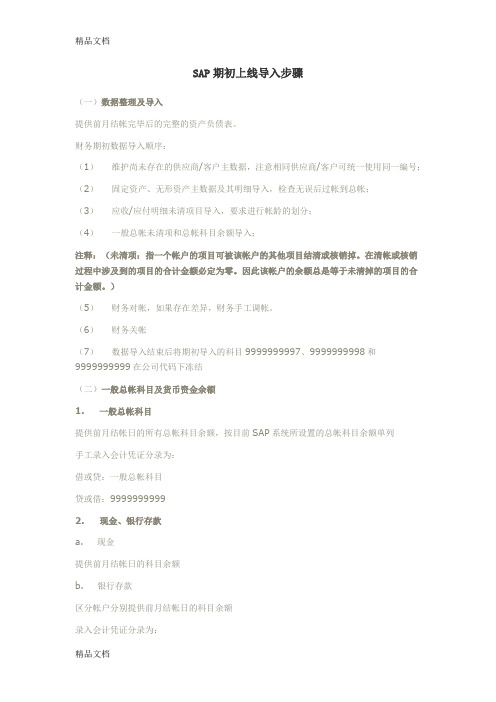
SAP期初上线导入步骤(一)数据整理及导入提供前月结帐完毕后的完整的资产负债表。
财务期初数据导入顺序:(1)维护尚未存在的供应商/客户主数据,注意相同供应商/客户可统一使用同一编号;(2)固定资产、无形资产主数据及其明细导入,检查无误后过帐到总帐;(3)应收/应付明细未清项目导入,要求进行帐龄的划分;(4)一般总帐未清项和总帐科目余额导入;注释:(未清项:指一个帐户的项目可被该帐户的其他项目结清或核销掉。
在清帐或核销过程中涉及到的项目的合计金额必定为零。
因此该帐户的余额总是等于未清掉的项目的合计金额。
)(5)财务对帐,如果存在差异,财务手工调帐。
(6)财务关帐(7)数据导入结束后将期初导入的科目9999999997、9999999998和9999999999在公司代码下冻结(二)一般总帐科目及货币资金余额1. 一般总帐科目提供前月结帐日的所有总帐科目余额,按目前SAP系统所设置的总帐科目余额单列手工录入会计凭证分录为:借或贷:一般总帐科目贷或借:99999999992.现金、银行存款a. 现金提供前月结帐日的科目余额b. 银行存款区分帐户分别提供前月结帐日的科目余额录入会计凭证分录为:借:现金/银行存款贷:9999999999(三)票据科目余额1.一般总账科目:应收票据-银行承兑/贴现在途“应收票据-银行承兑”、“应收票据-贴现在途”是一般总帐科目管理,不是未清项明细管理,提供前月结帐日的总帐科目余额,录入会计凭证分录为:借:应收票据贷:99999999992.总账未清项明细管理:应收票据-商业承兑、应付票据-银行承兑/商业承兑在SAP中的总帐科目中,该科目为明细管理,必须按明细项目单列并区分借贷方单列;提供客户(或供应商)应收/应付票据的特别总帐标识,应收/应付票据的出票人、受票人名称、票据到期日等信息;必须保证明细总额与总帐科目余额一致导入分录为:借:应收票据-商业承兑贷:9999999999或借:9999999999贷:应付票据-商业/银行承兑(四)存货1. 存货数据导入的步骤:(1)在导库存数量之前,必须先按sd提供的物料编码将标准价格导入系统,导入方式为CATT,维护会计视图1中的标准价格、评估类及成本视图1中的物料源(2)库存导入的数量是盘点的实物库存数量,由sd模块导入。
SAP 三种批量导入方法
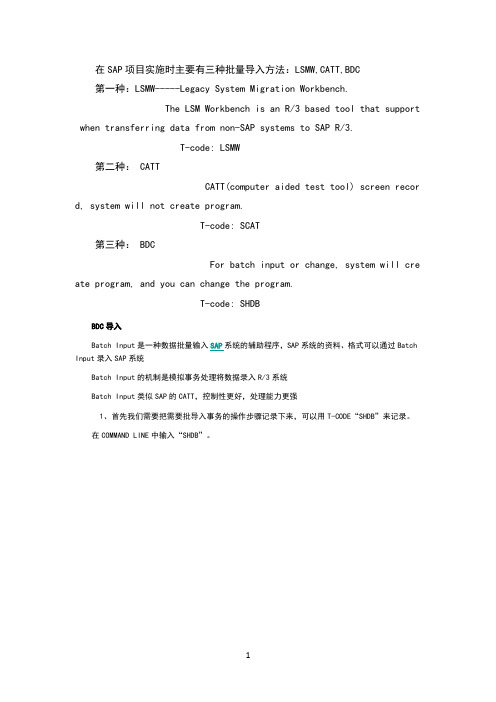
在SAP项目实施时主要有三种批量导入方法:LSMW,CATT,BDC第一种:LSMW-----Legacy System Migration Workbench.The LSM Workbench is an R/3 based tool that support when transferring data from non-SAP systems to SAP R/3.T-code: LSMW第二种: CATTCATT(computer aided test tool) screen recor d, system will not create program.T-code: SCAT第三种: BDCFor batch input or change, system will cre ate program, and you can change the program.T-code: SHDBBDC导入Batch Input是一种数据批量输入SAP系统的辅助程序,SAP系统的资料、格式可以通过Batch Input录入SAP系统Batch Input的机制是模拟事务处理将数据录入R/3系统Batch Input类似SAP的CATT,控制性更好,处理能力更强1、首先我们需要把需要批导入事务的操作步骤记录下来,可以用T-CODE“SHDB”来记录。
在COMMAND LINE中输入“SHDB”。
2、进入TRANSACTION RECORDER界面3、点“NEW RECORDER”创建一个记录,现在以修改订单为例,键入记录名“ZAMAO”,输入事务代码“VA02”,然后“START RECORDING”。
4、下面的任务就是记录下修改订单的操作步骤。
5、填入订单号码,按确定6、现在来增加一下订单的PO DATE。
7、填入“,点“保存”。
8、这样就完成了一个最最简单的BDC录取工作,录完之后会出现系统运行的操作的跟踪,包括程序号,屏幕号,字段名,值等等,下面的任务是根据这些写到程序里面以完成SAP自动跑订单修改的这一动作。
SAP数据导入程序说明

SAP数据导入程序说明SAP/ERP Project文件编号: MDL-2.1-051903v1-01项目管理文档Using Data Transfer ProgramsContentsOverview (2)G/L Account Master (2)Material Master (6)Bills of Material (15)Routings (19)Vendor Master (26)Customer Master (32)Purchasing Information Record (38)Condition Record (Pricing) (42)Purchase Requisition (45)Open Sales Order (49)Accounting Documents (Open A/R and A/P Invoices) (53)Stocks (Material Movements) (58)Plant Maintenance: Several Business Objects (61)Personnel Planning (68)Planned Independent Requirement (73)Production Order (76)SAP/ERP Project项目管理文档OverviewFor at least one business object of each application the following information is provided:What the program doesThese sections help you become familiar with the data transfer program supportingparticular business objects or mention that there is no program (for example, ProductionOrder). These sections explain the use of each program and provide the menu paths andthe transaction codes associated with the business object.Transferring business objects at a glanceThese sections list the major steps needed to perform the data transfer for certainbusiness objects. Programs that facilitate the data transfer process are listed (for example,to display or edit a flat file).An example of the programThese sections provide examples for each program. The disk inside the back cover of thisguide contains the data to be used for these examples. For more information, pleaseopen readme.txt on the diskette.The required flat file in detailThese sections list the record structures used by flat files and the fields that aremandatory regardless of your specific settings. Depending on your system, there will bemore fields required to successfully transfer a business object into your R/3 System.Note that you only have to use a record within a flat file if you provide other fields thanthose for STYPE or TBNAM.G/L Account MasterWhat Does the Program Do?The general ledger (G/L) account master creates and changes its data with a BI method. Theprogram RFBISA00 processes the data created and changed in the G/L account master.The following menu paths and transaction codes are associated with the G/L accountmaster:XXXX SAP/ERP Project文件编号: MDL-2.1-051903v1-01项目管理文档To access the G/L account master menu, choose Accounting → Financial accounting →General ledger.To create the G/L account from the G/L account master menu, choose Master records →Create (FS01).To change the G/L account from the G/L account master menu, choose Master records →Change (FS02).To block or unblock the G/L account from the G/L account master menu, choose Master records → Block/unblock (FS05).To set or cancel the G/L account from the G/L account master menu, choose Master records → Mark for deletion (FS06).Transferring G/L Accounts at a GlanceTo transfer the G/L account master:1.Prepare the flat file from your legacy data.2.Run the program RFBISA00 to create a BI session.3.Process the session to transfer the data.The accounting documents program supports the customer-specific record structuresZSKA1, ZSKAT, and ZSKB1, instead of the standard structures BSKA1, BSKAT, and BSKB1.SAP/ERP Project项目管理文档An Example of Transferring G/L Account Data1. Start program RFBISA00 (SE38).2. Enter accounts.txt (the flat filename). 3. Deselect Check file only .The default program controloption is Check file only . Deselect this option to create a session. 4. Choose Execute .5. Start the BI program to process thesession.For more information, see How to … Start an SAP Program and How to … Start a Batch Input Session in chapter 3.The Required Flat File in DetailThe following is a sample of the flat file: The screenshot to the right shows what accounts.txt looks like.234XXXX SAP/ERP Project文件编号: MDL-2.1-051903v1-01项目管理文档Define an entry for each field with one of the following:The value of a field (certain value)A space to delete an entry when changing a field’s contents (RESET value)The special character“/” to transfer no value (NODATA value)This program also supports the flat files of earlier R/3 releases.In record structures where the field is available, enter “/” in the SENDE field. This enablesthe program to work with flat files created for earlier R/3 versions. The missing fields willbe filled with the NODATA value.Session Header Record BGR00This session header contains general information to control the BI session. Sending a secondsession prefix closes the current session and opens a new session. Information that affectsthe entire BI session is defined in the session prefix.Special fields in the session prefix are described as follows: STYPE is a record type indicator. Assign '0' to this field in BGR00.GROUP is a BI session name. Provide a distinctive label to help in session management.START is a block date. If a date is assigned here, the session cannot be started before this date. Please note that this date must be in the YYYYMMDD format.MANDT is the client in which the session is to be created.USNAM is the user owning the session.XKEEP field with value 'X' prevents the BI session from being deleted after a successful process.NODATA is a special character that indicates you have no data for the field. Preferably, use '/' as this character.Header Record BSK00BSK00’s mandatory fields are at least the record type (STYPE = 1) and a transaction codebased on the functionality you want to use (for example, TCODE = FS01).Chart of Accounts Data Record BSKA1BSKA1’s m andatory fields are at least the record type (STYPE = 2) and the table name(TBNAM = BSKA1).Name of G/L Accounts Record BSKATBSKAT’s mandatory fields are at least the record type (STYPE = 2) and the table name(TBNAM = BSKAT).SAP/ERP Project项目管理文档Company Code Data Record BSKB1BSKB1’s mandatory fields are at least the record type (STYPE = 2) and the table name(TBNAM = BSKB1).Material MasterWhat Does the Program Do?The material master data transfer program is one of the most important programs in thesystem. Material items are prerequisites for many other data elements, and setting up thematerial master is crucial for everything else to work properly.The material master creates and changes the material with the direct input (DI) technique.The following menu paths and transaction codes are associated with the material master:To access the material master menu, choose Logistics→Materials management→Material master.To create a material master from the material master menu, choose Material→Create(general) →Immediately (MM01).To change a material from the material master menu, chooseMaterial → Change →Immediately (MM02).The material master program cannot be used to transfer the: Units of measure groupClassification (there is a special program to transfer this data) Sales priceTransfer Material Master at a GlanceTo transfer material masters with DI:1.Prepare the flat file from your legacy data.2.Start the program RMDATIND.This program checks and posts your material master items into the R/3 database.3.Check error file with program RMDATINF for materials that could not be transferred.If you run RMDATIND directly and receive an abort message, you cannot restart theprogram! If you do not purge your flat file manually from the already posted records arestart may recreate existing records.If you use the DI administration transaction BMV0 to run the data transfer of the materialmaster, restarting is easy. For more information on using BMV0, please see How to …XXXX SAP/ERP Project文件编号: MDL-2.1-051903v1-01项目管理文档Transfer Data via Direct Input in chapter 3.The following additional features will facilitate your transfer: Generate test data.The program RMDATGEN generates sample flat files from an existing material master.Run this program to create your sample flat file.Display or edit the flat file.Use the Data Transfer Workbench to access the editor available there.Activate the customer-specific structure.Replace the 369-field structure, BMMH1, with a subset of that structure called ZMMH1that contains the fields you really want to transfer. Always run program RMDATING toactivate structure ZMMH1 or BMMH1 after you create or delete ZMMH1.Synchronization Between Master Data Enhancements and Data Transfer StructuresThe material master can be enhanced through customization. New fields can be added andnew views can be created, or existing views can be extended. When this enhancement isdone on the material master object, care has to be taken that corresponding data transferstructures are also enhanced.When, for example, the enhancement of the material master object is complete, the tablesMARA, MARC, and so on, change. But the corresponding data transfer structures BMM00,BMMH1, and so on, are not automatically modified.When customizing the material master, the Online Service System note 0038229 has to beapplied.An Example of the Material Master Data TransferThe following example shows you how to transfer materialmaster data. For moreinformation, see material.txt, a sample flat file on the disk inside the back cover of this guide.Copy material.txt into the working directory of your application server. Make sure that thelogical file name used in the material master, MATERIAL_MASTER_BTCI, is linked to theflat file you want to use.For more information, see the following sections in chapter 3:How To … Transfer Data via Direct InputHow To … Use Customer Defined Flat File StructuresHow To … Display/Edit a Flat FileHow To … Maintain Physical Address for Logical File Names SAP/ERP Project项目管理文档1. Start the program RMDATINDusing transaction SE38. 2. Use the DI administrationprogram for the final data transfer that ensures the possibility of a restart. 3. Select the parameters. Theparameters you choose under the Check file determine the processing checks that will occur.The following is an explanation of the different parameters: Check fileIf Only import file is selected, the data is read from the input file, but is not checked.All data is transferred to the error file.If Check data, but do not update is selected, the program performs most integrity checks,but data is not updated. Only logically incorrect data remainsin the error file. Logically correct data is removed from the input file, but is not updated.General dataIf Lock mode is selected, it defines how transferred material numbers will be locked.When transferring data for the first time, do not set any locks (mode N ). However, when transferring data to a system in productive operation, set locks (mode E ). ? Max. no. of logical errors determines the number of logical errors that are accepted before the data transfer program is terminated with a corresponding error message. ? Transactions per commit unit determines the number of transactions to be processed ina physical step. The higher the number of transactions, the less frequently the system accesses the database, which increases the internal table size. The smaller the number of transactions, the more frequently the system accesses the database, 23XXXX SAP/ERP Project文件编号: MDL-2.1-051903v1-01项目管理文档reducing the internal table size. By changing these numbers, you may be able toimprove transfer performance; unfortunately no general recommendation as to sizecan be made. However, 500 is a good starting value.Message level (1-4) determines the types of system messages that will be written to the log file. The higher the value, the greater the number of messages written to the job log.Level Message1 Abends only (Abend = abnormal end)2 Abends and errors3 Abends, errors, and warnings4 All messagesFields not ready for input defines how fields not ready for input are to be treated. The value entered here determines which, if any, of the following messages will be written tothe job log.Value Message TypeE E message (error)W W message (warning)I I message (information)Blank No messageRegardless of these values, all messages are saved so that you can view them with theprogram RMDATINF.The fewer options you choose for each of the following parameters, the less time the transferwill take:Set up administrative dataIf this parameter is not selected (the default), the tables MOFF (outstanding status) andMSTA (administrative data) are not updated. After a successful data transfer, to use thematerial mast er’s functionality for the materials transferred, run program RMMMVERWto update the data.If you select Create change documents“change documents” are created.Update MRP records creates MRP records for the respective materials.4.Press F8 or click Execute to start the program.SAP/ERP Project项目管理文档5.Choose Enter to acknowledgethat the program works.6.Choose Enter to acknowledgethe valuation level. (Thisdepends on your configuration.)7.Choose Enter to acknowledge“/” as the NODATA value forthe session.8.Choose Enter to acknowledgethe success or failure of theprogram. This screen showshow many transactions wereposted. (In our example, onetransaction was posted.)9.The screenshot to the rightshows the final result of theprogram run. 56789XXXX SAP/ERP Project文件编号: MDL-2.1-051903v1-01项目管理文档The Required Flat File in DetailDefine an entry for each field with one of the following:An entered field value (certain value)A space to delete an entry when changing the contents of a field (RESET value)The special character “/” to transfer no value (NODATA value)If you have included new fields in the append structures for MARA, MARC, or othermaterial master tables (and have also appended these tables to BMMH1 to supply them byDI), run program RMDATING by setting the parameter Generate coding for MGAD toregenerate program parts for RMDATIND. Otherwise, the appended fields will not besupplied with data.The material number can be explicitly defined (external number assignment) or determinedby the system (internal number assignment).If you decide to use external numbers, always specify the material number in your flat file. Ifyou are unsure whether a material item has already been created in your R/3 System (andperformance is not critical), copy your flat file entries for each material. Then create thematerial (BMM00-TCODE= ‘MM01’) and change the material (BMM00-TCODE= ‘MM02’).If you decide to use internal number assignment you must use:A “space” in the material number when you crea te a new material.The “0”to extend the material just created (for example, tocreate the material for another organizational unit—for example, plant).The appropriate material number if you want to change a specific material master item.If you use the online transaction, create a material master with reference to an existingmaterial. You cannot use this functionality if you automatically transfer materials, becausethe reference settings will be ignored.The following screen shows mandatory and optional data. The screen also illustrates thedifferent elements that may be used.SAP/ERP Project项目管理文档To the right, a flat fileis displayed withinthe Data TransferWorkbench.The field entries you make must be in the output format. Only entries in the fields thatmaintain period consumption and forecast values can be in the YYYYPPDD format, asexplained below:YYYY – a four-digit year (for example, 1998)PP – a two-digit periodDepending on the period indicator and fiscal year variant in structure BMMH1, thesedigits signify:The month for monthly periods.The specified fiscal year variant in the case of daily periodsor posting periods.Week with weekly periods.DD – two digit day within the period PP.Session Record BGR00This session header contains general information to control the session. Sending a secondsession prefix causes the current session to be closed and a different session to be opened(first line in the example screen).Special fields in the session prefix are:STYPE is a record type indicator. Assign '0' to this field in BGR00.GROUP is a BI session name. Provide a distinctive label to help in session management.XXXX SAP/ERP Project文件编号: MDL-2.1-051903v1-01项目管理文档START is a block date. If a date is assigned here, the session cannot be started before this date. Please note that this date must be in the YYYYMMDD format.MANDT is the client in which the session is to be created.USNAM is the user owning the session.XKEEP field with value 'X' prevents the BI session from being deleted after a successful process.NODATA is a special character that indicates you have no data for the field. Preferably, use ' ' as this character.Header Record BMM00There is one header record for each transaction (for example, material). All line item recordsup to the next header record are assigned to the previoustransaction. In addition to thetransaction code, because of the Select View(s) and Organizational Levels/Profiles dialog boxes,the header record contains all data for the initial screen.To create a material master record at several organizational levels of the same type (forexample, several storage locations for a plant) create each organization level individually.The header record contains the:Record type (STYPE = 1)Transaction code (TCODE MM01), which creates a material master (use MM02 to change it)Record end indicator (SENDE), which is set to “/”Organizational units that are relevant for the selected views Views required according to your functional needs (optional) The selected views can be specified directly if you enter an X into the correspondingfields. If you do not enter anything into the view selection fields, the program will createviews based on the entered data. For example, if an MRP view field contains a value, theview to enter this value is created.If you transfer data to BMMH1, which belongs to an organizational level that is notspecified in BMM00, this data will be ignored without warning.If data is incomplete, a warning or an error message is produced. Entry fields that belongto an active view, but are not ready for input or are hidden because of field selection, arereset with a message.SAP/ERP Project项目管理文档Main Data BMMH1There is exactly one main data record for each transaction. This record contains the data forthe main screens, conversion factors for the different units of measure, the additionalforecast parameters, and tax classifications for the sales organization’s country. Thisstructure is usually sufficient and you will not need to transfer other structures.The main record contains at least the mandatory fields record type (STYPE = 2) and therecord end indicator (SENDE = “/”).If the customer-specific structure ZMMH1 is used instead of the standard structureBMMH1, ZMMH1 must exist in the repository and be active. This structure, however,does not come with the standard R/3 System; you must create it.You can create the structure so that it contains only fields that exist also in BMMH1. If youinclude fields in ZMMH1 that do not exist in BMMH1, the DI transfer program will runwithout stopping, and these additional fields will be ignored. Do not delete any requiredfields (for example, STYPE).If you create or delete ZMMH1, you must run the generator RMDATING beforetransferring data by DI. Never delete required fields from the structure! If you areworking with a customer-defined structure, the record type field (STYPE) also has to beset to “Z.”Country Data BMMH2For each additional country, you need structure BMMH2 with record type (STYPE = 3) andthe corresponding tax data.The records from BMMH2 to BMMH8 are necessary only if you require additional data inthe respective area that cannot be transferred with BMMH1.Forecast Values BMMH3For each forecast period use structure BMMH3 and set the record type STYPE = 4.Consumption Values BMMH4To add consumption data for each consumption period, use structure BMMH4 and set therecord type STYPE = 5.Description (Short Texts) BMMH5One description (short text) record of structure BMMH5 is required for each additionallanguage. Set record type STYPE = 6.XXXX SAP/ERP Project文件编号: MDL-2.1-051903v1-01项目管理文档Units of Measure BMMH6One unit of measure record of structure BMMH6 is required for each alternative unit ofmeasure. Set record type STYPE = 7.Long Texts BMMH7One long text record of structure BMMH7 is required for each line of long text and for eachlanguage. Set record type STYPE = 8. Depending on the text you want to maintain you haveto set the text ID (TDID) for each language:The following are possible text IDs:Purchase order text TDID = ‘BEST’Sales text TDID = ‘0001’Inspection text TDID = ‘PRUE’Basic data text TDID = ‘GRUN’Internal comment TDID = ‘IVER’The format character at the beginning of each line is directly transferred. No query is madefor NODATA. The format character is always the same as the content of BMMH7-TDFORMAT field and is directly transferred. The NODATA logic is not used for this field.If you want to change a long text, specify the entire text in its new form. Do not use the DImethod to delete long texts.Additional EANs or UPCs for the Unit of Measure BMMH8If you need different EAN s or UPC s for the same article, because you get them fromdifferent manufacturers, transfer them using structure BMMH8 and set the record typeSTYPE = 9.Bills of MaterialWhat Does the Program Do?There are four programs involved with bills of material(BOMs). The first program createsregular BOMs and the second can change them. Additionally there is a program to createvariant BOMs and one to create BOMs with long texts. All programs offer BI or CallTransaction.SAP/ERP Project项目管理文档These programs support the creation of document structures, equipment BOMs, materialBOMs, standard object BOMs, and functional location BOMs. The programs read theentered sequential files and process the data in each file.To access the bills of material menu, choose Logistics → Production → Master data → Bills ofmaterial. Depending on the kind of BOM you want to create or change, choose the correctentry after Bills of material.Transferring Bills of Material at a GlanceTo transfer BOMs:1.Prepare the flat file from your legacy data.2.Define a logical file name.3.Run program RCSBI010 to create BOMs, or run program RCSBI020 to change BOMs.Both programs will create a BI session.4.Process the session to transfer the data.You can edit/display the flat files for all four BOM Programs within the Data TransferWorkbench. Program RCSBI030 also creates variant BOMs and program RCSBI040 createsBOMs with long texts.An Example of a Bill of MaterialThe following example shows you how to transfer a BOM for an existing material master.This example creates a BOM for material “Printer.” Because there are different programs tocreate and change this BOM, this example will only work once.You can change the BOM number used in this example with the edit program, RCCSBISC.This allows you to reuse the example.Make sure that the logical filename CS_BI_VARIANT_BOM_CREATE points to the physicalfile name. In this example, we have set this logical file name to point to bom.txt in theworking directory. For more information, see How To... Start a Batch Input Session andMaintain Physical File Name for Logical File Name in chapter 3.XXXX SAP/ERP Project文件编号: MDL-2.1-051903v1-01项目管理文档1. To create BOMs,start program RCSBI010. 2. Enter the logical filename.If you do not select Create session , the program will do a Call Transaction. If it is selected, a BI session is created. 3. Choose Execute.The Required Flat File in DetailDefine an entry for each field with the following: An explicitlyentered field value (certain value)The special character “!” to delete an entry when changing field contents (RESET value) The character “space” to transfer no values (NODATA value) The screenshot to the right displays a flat file in the Data Transfer Workbench.23SAP/ERP Project项目管理文档Session Header Record BGR00This session header contains general information to control the BI session. Sending a secondsession prefix closes the current session and opens another different session. Theinformation that affects the BI session is defined in the session prefix.Special fields in the session prefix are described as follows: STYPE is a record type indica tor. Assign ‘0’ to this field in BGR00.GROUP is a BI session name. Provide a distinctive label to help in session management.START is a block date. If a date is assigned here, the session cannot be started before this date. Please note that this date must be in the YYYYMMDD format.MANDT is the client in which the session is to be created.USNAM is the user owning the session.XKEEP field with value ‘X’ prevents the BI session from being deleted after a successful process.NODATA is a special character that indicates you have no data for the field. Preferably, use ‘ ‘ as this character.Header Record BICSKThe header record indicates the beginning of a new transaction:The record type STYPE is 1.The BICSK-TCODE field determines the SAP transaction that is called. Do not mix the create BOMs and change BOMs in one flat file, because specific programs exist thatperform either create or change. The following entries are possible:CV11 to create and CV12 to change document structuresIB01 to create and IB02 to change equipment BOMsCS01 to create and CS02 to change material BOMsCS51 to create and CS52 to change standard BOMsIB11 to create and IB12 to change functional location BOMs Item Data Record BICSPThe record type STYPE is 2.Subitem Record BICSUThe record type STYPE is 3.XXXX SAP/ERP Project文件编号: MDL-2.1-051903v1-01项目管理文档RoutingsWhat Does the Program Do?This program creates routings (task lists) with the BI method.To access the routings menu, choose Logistics → Production → Master Data → Routings.There are two ways to create a routing from the routings menu:Routings → Routing → Create (CA01)Routings → Ref. Operation Set → Create (CA11)Apart from using the BI method, you can create a DI program by using the functionsCP_BD_DIRECT_INPUT_PLAN or CP_BD_DIRECT_INPUT_PLAN_EXT depending on theavailable format. The advantage is that these functions increase speed (factor 2 to 8 over theBI) and perform all needed checks.For more information as well as additional functions, please check documentation infunction group CPBD.Transferring Routings at a GlanceThree major steps are involved in transferring routings:1.Prepare a flat file from your legacy data.2.Start the program RCPTRA01 to create the BI session.3.Process the BI session.Furthermore, the program RCPBTCO1 creates the flat file for existing routings. Thisprogram creates these files for testing, or you may use it to create the file that transfersexisting routings from one R/3 System to another.An Example of Transferring Routings1.Start program RCPTRA01.2.Enter routing.txt.3.Choose Execute.32。
sap 数据迁移解决方案

sap 数据迁移解决方案
《SAP数据迁移解决方案》
随着企业信息化程度的不断提升,越来越多的企业开始采用SAP系统来管理其业务流程。
而随着业务的扩展和发展,企
业可能需要进行SAP数据迁移,以便将旧系统中的数据迁移
到新系统中,或进行系统升级等操作。
在这个过程中,如何高效、安全地进行SAP数据迁移成为了企业关注的焦点。
针对SAP数据迁移问题,企业需要寻找合适的解决方案。
首先,企业可以选择通过SAP自带的数据迁移工具进行迁移操作,比如SAP Data Services、SAP Landscape Transformation等。
这些工具可以帮助企业快速、准确地完成数据迁移,确保数据的完整性和一致性。
其次,企业还可以选择第三方的SAP数据迁移解决方案,这
些解决方案往往更加全面、专业,并且提供了更多的定制化服务。
通过与专业的SAP数据迁移服务提供商合作,企业可以
获得更好的技术支持和解决方案,确保SAP数据迁移的顺利
进行。
另外,在进行SAP数据迁移时,企业还需要注意数据的安全
性和合规性。
因此,在选择SAP数据迁移解决方案时,企业
需要考虑厂商的信誉和数据安全保障措施,确保数据在迁移过程中不会丢失或泄露。
总的来说,针对SAP数据迁移问题,企业需要根据自身实际
情况,选择合适的解决方案,确保数据迁移的顺利进行。
通过合适的解决方案,企业可以提高工作效率,降低风险,实现SAP系统的顺利迁移和升级。
sap三种批量导入方法
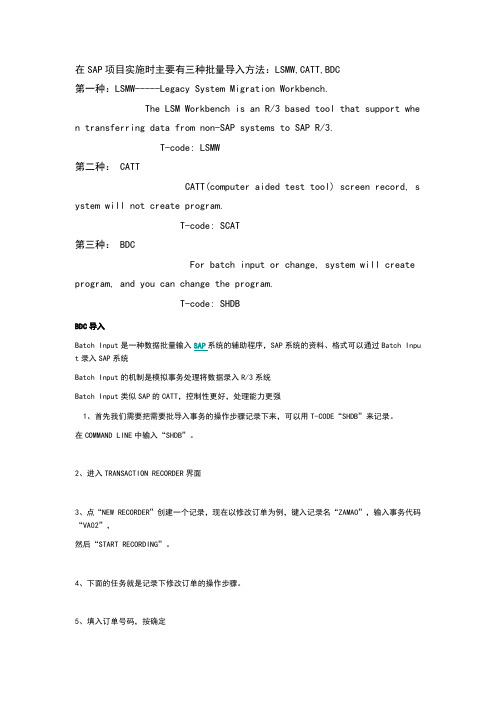
在SAP项目实施时主要有三种批量导入方法:LSMW,CATT,BDC第一种:LSMW-----Legacy System Migration Workbench.The LSM Workbench is an R/3 based tool that support whe n transferring data from non-SAP systems to SAP R/3.T-code: LSMW第二种: CATTCATT(computer aided test tool) screen record, s ystem will not create program.T-code: SCAT第三种: BDCFor batch input or change, system will create program, and you can change the program.T-code: SHDBBDC导入Batch Input是一种数据批量输入SAP系统的辅助程序,SAP系统的资料、格式可以通过Batch Inpu t录入SAP系统Batch Input的机制是模拟事务处理将数据录入R/3系统Batch Input类似SAP的CATT,控制性更好,处理能力更强1、首先我们需要把需要批导入事务的操作步骤记录下来,可以用T-CODE“SHDB”来记录。
在COMMAND LINE中输入“SHDB”。
2、进入TRANSACTION RECORDER界面3、点“NEW RECORDER”创建一个记录,现在以修改订单为例,键入记录名“ZAMAO”,输入事务代码“VA02”,然后“START RECORDING”。
4、下面的任务就是记录下修改订单的操作步骤。
5、填入订单号码,按确定6、现在来增加一下订单的PO DATE。
7、填入“,点“保存”。
8、这样就完成了一个最最简单的BDC录取工作,录完之后会出现系统运行的操作的跟踪,包括程序号,屏幕号,字段名,值等等,下面的任务是根据这些写到程序里面以完成SAP自动跑订单修改的这一动作。
SAP期初上线导入步骤

SAP期初上线导入步骤导入数据是SAP系统上线前的重要步骤之一、这个过程涉及将组织在现有系统中存储的数据转移到SAP系统中。
以下是一个关于SAP期初上线导入步骤的详细描述。
1.确定数据需求:在开始导入数据之前,必须明确需要导入的数据类型和数量。
这可以通过与业务部门和相关团队沟通来确定,以确保所导入的数据满足业务需求。
2.数据清洗和准备:在将数据导入SAP系统之前,必须先进行数据清洗和准备。
这包括检查数据的完整性、准确性和一致性。
需要修复错误和不一致的数据,并确保数据格式与SAP系统的要求相符。
3. 数据转换:可能需要对数据进行转换,以使其适应SAP系统的数据结构和字段。
这可以通过使用数据转换工具来完成,例如Microsoft Excel或专用数据转换软件。
转换后的数据应符合SAP系统的数据格式规范。
4.数据映射:数据映射是将现有系统的数据字段映射到SAP系统的数据字段的过程。
这需要一个详细的映射表,将现有系统中的每个字段对应到SAP系统中的相应字段。
标准SAP系统提供了一些默认字段映射,但可能需要进行自定义映射。
5.数据加载:数据加载是将清洗、准备和转换后的数据导入SAP系统中的过程。
这可以通过使用SAP提供的数据导入工具或第三方数据导入工具来完成。
在加载数据之前,必须先创建相应的数据对象和表结构,以便正确地导入数据。
6.数据验证和校验:在将数据加载到SAP系统中之后,必须进行数据验证和校验,以确保数据的正确性和完整性。
这可以通过运行预定义的校验规则来完成,以及与业务部门的确认和核对。
7.错误处理:在数据导入的过程中,可能会发生错误和异常情况。
这可能包括数据格式错误、字段映射错误或数据丢失等。
必须制定相应的错误处理策略,并及时解决错误,以确保数据的准确性。
8.数据后续处理:在成功导入数据后,可能需要进行一些后续处理。
这可以包括数据分析、数据合并、数据转换和数据匹配等,以满足业务需求。
9.数据迁移测试:在实际导入SAP系统之前,必须进行数据迁移测试以验证数据导入的正确性和完整性。
SAP期初上线导入步骤

SAP期初上线导入步骤SAP(Systems, Applications, and Products in Data Processing)是一种企业资源规划(ERP)系统,用于管理和整合企业各个部门的业务流程。
期初上线导入是指在企业首次启用SAP系统时,将历史数据导入到系统中,以确保系统能够正确反映企业的现实情况。
以下是SAP期初上线导入的详细步骤:1.数据准备和清理:在开始导入之前,需要对历史数据进行准备和清理。
这包括检查和纠正数据的完整性、一致性和准确性,确保数据符合SAP系统的要求。
2.数据提取:从现有系统或电子表格中提取历史数据。
这可能涉及到编写和运行特定的数据提取程序或使用数据集成工具。
3.数据转换和准备:将提取的数据转换为SAP系统可接受的格式。
这包括对数据进行重命名、重新编码和重新分类,以符合SAP系统的数据模型和结构。
4.数据加载:将转换后的数据加载到SAP系统中。
这可以通过批量输入、数据导入程序或直接数据库访问来完成。
5.数据验证和校验:在加载数据之后,需要对导入的数据进行验证和校验,以确保数据的准确性和完整性。
这可以通过运行事务代码、运行自动检验程序或进行手动检查来完成。
6.错误处理和纠正:如果发现数据错误或不匹配,需要进行错误处理和纠正。
这可能包括修正数据、重新加载数据或重新运行数据转换过程。
7.数据调整和调整:在导入数据后,可能需要进行一些调整和调整,以便SAP系统能够正确反映企业的现实情况。
这可能涉及到调整余额、更新交易记录或重新分类数据。
8.完整性和一致性检查:在导入数据完成后,需要进行完整性和一致性检查,以确保SAP系统中的数据与现实情况保持一致。
这可能包括运行系统检查、执行数据校验规则或进行数据比较。
9.数据迁移和转换:完成数据导入和调整后,可以开始进行系统迁移和转换。
这包括从现有系统切换到SAP系统,并确保所有业务流程和功能正常运行。
10.数据验证和验证:在完成数据迁移和转换后,需要对系统进行验证和验证,以确保数据的完整性和准确性。
sap三种批量导入方法
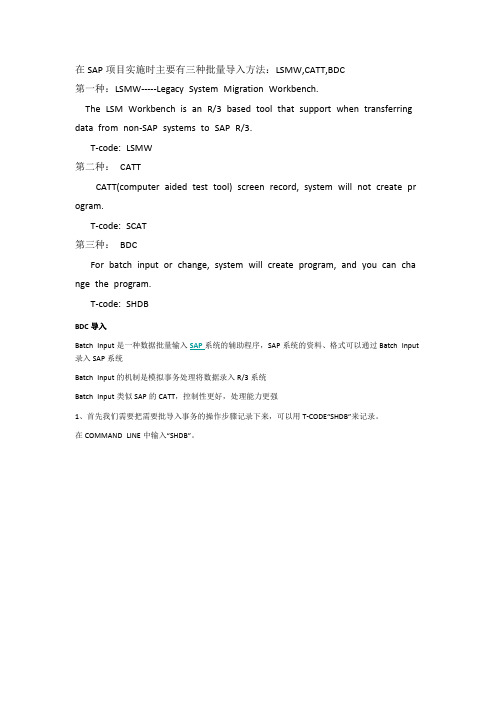
在SAP项目实施时主要有三种批量导入方法:LSMW,CATT,BDC第一种:LSMW-----Legacy System Migration Workbench.The LSM Workbench is an R/3 based tool that support when transferring data from non-SAP systems to SAP R/3.T-code: LSMW第二种:CATTCATT(computer aided test tool) screen record, system will not create pr ogram.T-code: SCAT第三种:BDCFor batch input or change, system will create program, and you can cha nge the program.T-code: SHDBBDC导入Batch Input是一种数据批量输入SAP系统的辅助程序,SAP系统的资料、格式可以通过Batch Input 录入SAP系统Batch Input的机制是模拟事务处理将数据录入R/3系统Batch Input类似SAP的CATT,控制性更好,处理能力更强1、首先我们需要把需要批导入事务的操作步骤记录下来,可以用T-CODE“SHDB”来记录。
在COMMAND LINE中输入“SHDB”。
2、进入TRANSACTION RECORDER界面3、点“NEW RECORDER”创建一个记录,现在以修改订单为例,键入记录名“ZAMAO”,输入事务代码“V A02”,然后“START RECORDING”。
4、下面的任务就是记录下修改订单的操作步骤。
5、填入订单号码,按确定6、现在来增加一下订单的PO DATE。
7、填入“,点“保存”。
8、这样就完成了一个最最简单的BDC录取工作,录完之后会出现系统运行的操作的跟踪,包括程序号,屏幕号,字段名,值等等,下面的任务是根据这些写到程序里面以完成SAP自动跑订单修改的这一动作。
2024版SAP数据批量导入教程与BDC实例详细讲解

SAP数据批量导入教程与BDC实例详细讲解contents •引言•SAP数据批量导入概述•BDC实例详细讲解:准备阶段•BDC实例详细讲解:执行阶段•SAP数据批量导入实践:案例分享•总结与展望目录01引言03实现数据自动化处理通过编写脚本或使用第三方工具,可以实现数据的自动导入和处理,进一步提高工作效率。
01提高数据导入效率通过批量导入,可以快速将大量数据导入SAP 系统,提高数据处理的效率。
02减少手动输入错误手动输入数据容易出错,而批量导入可以大大减少这种错误的发生。
目的和背景教程范围SAP数据导入基本概念:介绍SAP数据导入的相关概念和术语,帮助读者更好地理解后续内容。
第三方工具介绍:介绍一些常用的第三方工具,如SAP Data Services、Winshuttle等,以及它们的特点和使用方法。
BDC(Batch Data Communication)详解:详细讲解BDC的原理、使用方法和最佳实践,包括如何创建BDC会话、编写BDC程序等。
批量导入实例演示:通过具体实例演示如何使用BDC和第三方工具进行SAP数据批量导入,包括数据准备、02SAP数据批量导入概述批量导入的定义与作用定义批量导入是指将大量数据从外部源快速、高效地导入到SAP系统中的过程。
提高数据录入效率通过自动化工具,减少手动录入,加快数据处理速度。
保证数据准确性减少人为错误,确保数据的完整性和准确性。
促进业务连续性支持定期或实时的数据更新,确保系统数据的实时性和一致性。
SAP系统中的批量导入工具BDC(Batch Data Communicati…SAP提供的标准工具,用于批量导入数据。
它允许用户创建事务脚本,模拟用户在前端执行的事务。
LSMW(Legacy System Migrati…用于从非SAP系统迁移数据到SAP系统。
它支持多种数据源格式,并提供数据转换和映射功能。
Data Services(DS)SAP的数据集成工具,提供ETL(提取、转换、加载)功能,支持复杂的数据转换和清洗需求。
(2024年)SAPSECATT数据批量导入功能

03
批量导入操作步骤详解
2024/3/26
11
登录SAPSECATT系统
打开SAPSECATT系统登录页面,输 入正确的用户名和密码。
点击“登录”按钮,进入系统主页面 。
2024/3/26
12
选择数据文件并上传
2024/3/26
01
在系统主页面中,找到“批量导入”功能选项,点 击进入批量导入页面。
15
04
功能实现原理及技术支持
2024/3/26
16
批量导入技术原理简述
2024/3/26
数据格式转换
SAPSECATT通过特定的数据格式转换工具,将外部数据源(如Excel、CSV等)转换为SAP系统可识别的数据格式, 以便进行后续的数据导入处理。
批量处理
利用SAP系统的批量处理功能,实现对大量数据的快速、高效导入。通过一次性加载多个数据记录,减少了单条记录 逐一处理的时间消耗,提高了数据导入效率。
14
执行批量导入操作
2024/3/26
01
在设置好导入参数和规则后,点击“开始导入”按钮,启动批量导入 操作。
02
系统将根据设置的参数和规则,自动解析数据文件并将数据导入到 SAPSECATT系统中。
03
在导入过程中,系统会显示导入进度和相关信息,以便用户了解导入 状态。
04
导入完成后,系统会生成导入报告,列出导入结果、错误信息等详细 信息,供用户查看和分析。
SAPSECATT數據批量導入功能
2024/3/26
1
contents
目录
2024/3/26
• 功能介绍与背景 • 數據准备与格式要求 • 批量导入操作步骤详解 • 功能实现原理及技术支持 • 常见问题排查与解决方案 • 功能优化建议及未来展望
SAP数据传输导入详解

SAP数据传输导⼊详解SAP Data Migration(SAP业务数据传输指南读书笔记及补充)z OverviewSAP的主数据,在上线前需要⼤批量的从遗留系统导⼊系统中,以⽀持系统运⾏。
或者在系统上线以后,定期需要从外部遗留系统获取⼤量数据导⼊SAP系统。
此时通过事务代码⼿动维护是不切实际的。
SAP提供的数据传输⼯具有LSMW(Legacy System Migration Workbench)和DXWB(Data Transfer Workbench)。
SAP提供的数据传输技术有Batch input, Direct input, Call transaction, BDC, IDoc和CATT等进⾏数据传输的过程要遵循以下⼏个步骤:1.确定业务对象数据字段和传输⽅法2.分析遗留系统,准备原始数据⽂件3.转换原始数据⽂件为SAP可⽤的⽂件4.通过SAP传输⼯具或者BDC等技术传输数据z SAP数据传输的⽅法和技术SAP批量数据传输主要有3种⽅法:1.SAP标准数据传输程序2.BAPI或者IDoc接⼝3.定制BDC程序SAP进⾏数据传输的技术主要有3种:1.批输⼊batch input BI2.直接输⼊direct input DI3.调⽤事务call transaction CT其中批输⼊和调⽤事务模拟了在线事务调⽤的过程,会进⾏数据的检查。
⽽直接输⼊虽然没有模拟在线事务调⽤过程,但是也会进⾏数据的检查。
传输的技术和⽅法是相对互相独⽴的,⽐如应⽤SAP标准传输程序,⼀般只提供⼀种(有的也有多种)传输技术。
再⽐如使⽤BDC,可以使⽤BI也可以使⽤CT的⽅式。
9SAP标准数据传输程序SAP中对⼤多数业务对象都提供标准数据传输程序,⽐如物料主数据是RMDATIND,材料单主数据是RCSBI010。
以下清单列出了SAP中主要的业务对象标准数据传输程序SAP记录格式标准数据传输程序要求输⼊的⽂件符合SAP相应的记录格式,不同业务对象的记录格式是不同的。
- 1、下载文档前请自行甄别文档内容的完整性,平台不提供额外的编辑、内容补充、找答案等附加服务。
- 2、"仅部分预览"的文档,不可在线预览部分如存在完整性等问题,可反馈申请退款(可完整预览的文档不适用该条件!)。
- 3、如文档侵犯您的权益,请联系客服反馈,我们会尽快为您处理(人工客服工作时间:9:00-18:30)。
SAP数据导入方案
1. 引言
数据导入是在SAP系统中常见的任务之一,它允许用户将外部系统中的数据导入到SAP系统中。
在本文档中,我们将讨论SAP数据导入的方案和最佳实践。
2. 数据导入方法
在SAP系统中,有多种方法可供选择来导入数据。
以下是一些常见的方法:
2.1 ABAP数据上传
ABAP数据上传是一种通过编写ABAP代码来实现数据导入的方法。
它允许用
户根据自己的需求和要求在SAP系统中创建自定义的导入程序。
这种方法适用于
复杂的数据导入任务,但需要具备编程知识。
2.2 SAP数据迁移对象 (DMO)
SAP数据迁移对象 (DMO) 是一个SAP提供的数据导入工具。
它允许用户使用
预定义的数据对象将外部系统中的数据导入到SAP系统中。
用户只需配置适当的
映射关系和转换规则,然后将数据文件上传到SAP系统即可。
2.3 第三方数据导入工具
除了SAP提供的工具之外,还有许多第三方工具可用于数据导入。
这些工具通常具有更友好的用户界面和更丰富的功能,可以更轻松地导入和转换数据。
一些流行的第三方工具包括IDoc导入工具、LSMW和BDC。
3. 数据准备
在进行数据导入之前,必须确保数据已经准备好并符合SAP系统的要求和限制。
以下是一些数据准备的最佳实践:
3.1 数据清洗
在导入数据之前,应该先对数据进行清洗。
这包括去除重复数据、修复格式错误、填充缺失的数据等。
数据清洗可以提高数据质量并减少错误。
3.2 数据映射
在将数据导入到SAP系统之前,必须确定外部系统中的数据如何映射到SAP
系统中的字段和对象。
这通常涉及到定义映射规则和配置转换逻辑。
确保正确的数据映射可以防止数据丢失或错误。
3.3 数据验证
在导入数据之前,应该先对数据进行验证。
这包括检查数据的完整性、一致性
和有效性。
确保数据的正确性可以提高SAP系统的数据质量和准确性。
4. 数据导入过程
在实际进行数据导入时,需要按照以下步骤来执行:
4.1 创建数据导入任务
首先,需要在SAP系统中创建一个数据导入任务。
这通常涉及到定义导入对象、映射规则和转换逻辑等。
4.2 准备数据文件
在执行数据导入任务之前,需要准备好数据文件。
数据文件可以是CSV、Excel
或其他格式的文件。
确保数据文件的格式与导入对象的要求相匹配。
4.3 执行数据导入任务
一旦数据文件准备好,即可执行数据导入任务。
根据所选择的导入方法,可以
使用ABAP代码、DMO或第三方工具来导入数据。
4.4 检查和验证数据
在数据导入完成后,需要对导入的数据进行检查和验证。
这包括检查数据的完
整性、一致性和准确性。
确保导入的数据符合预期可以提高SAP系统的数据质量
和可靠性。
5. 数据导入的注意事项
在进行数据导入时,需要注意以下事项:
5.1 备份数据
在进行数据导入之前,应该先备份SAP系统中的数据,以防止数据丢失或错误。
这可以通过导出数据到外部文件或创建SAP系统的数据快照来实现。
5.2 数据权限
在执行数据导入任务时,应该考虑数据权限的问题。
确保只有授权的用户或角
色可以访问和修改数据,以防止未经授权的数据操作。
5.3 监控和日志记录
在数据导入过程中,应该对操作进行监控并记录日志。
这可以帮助追踪数据导入的进度和结果,以及识别并解决潜在的问题和错误。
6. 总结
通过本文档,我们讨论了SAP数据导入的方案和最佳实践。
我们了解了不同的数据导入方法、数据准备和导入的过程,并提供了一些注意事项。
通过遵循这些最佳实践,可以确保数据导入的成功和可靠性。
